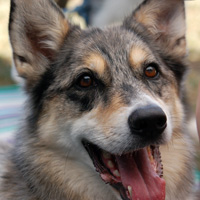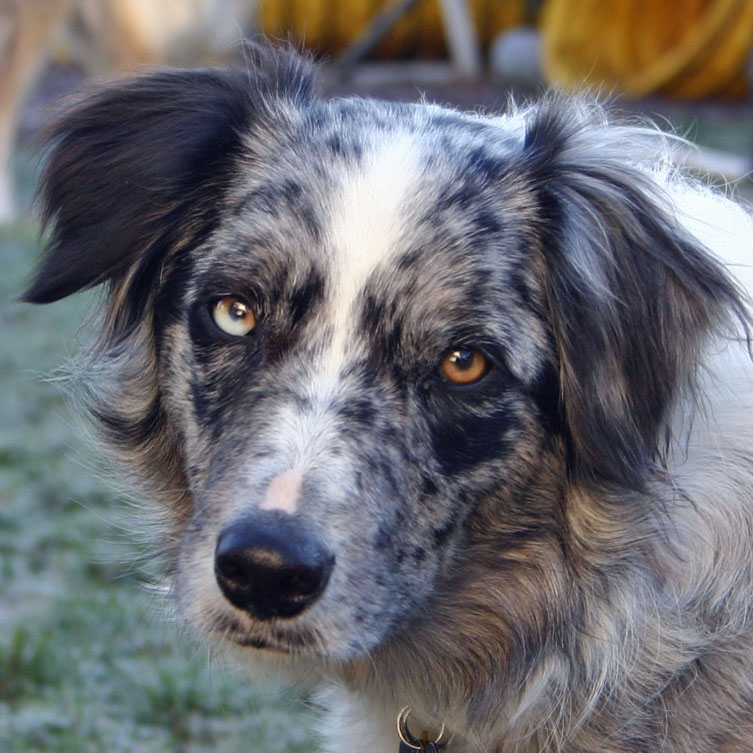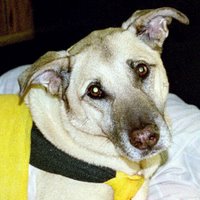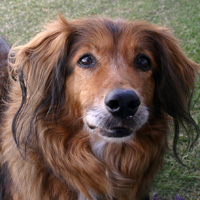SUMMARY: My sport of choice, but why?
Many Muddy Paws passed along this topic from another blogger and
made her own post on the subject.
What got you into your sport of choice...why that one, why not another type of dog sport? What else have you tried, but don't care for? What haven't you tried but would like to?Sometime in my teens, I decided that I wanted to train an Obedience Champion dog someday. When I got my first dog, Amber, I taught her come, sit, heel--but I had no real concept at all of how demanding obedience standards were.
Not that it mattered; when I signed up my mixed-breed dog with an AKC obedience class, they told me essentially that, if I wanted an obedience champion, I should get a purebred dog. I gave up on that idea for many years.
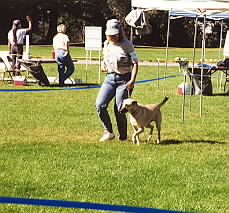
When Remington came along, I took up the competitive obedience thing again; Mixed Breed Dog Club of America and UKC (and others?) provided same titles with same rules for non-AKC dogs. Learned a lot. Took private lessons from an instructor with a lot of successful students. Remington did very well. But I didn't find it exciting, really, or particularly active, although the ideas for training intrigued me. Practice was dull dull dull. And, the more I found out about the rigid SUBJECTIVE performance standards, the less thrilled I became. But I kept with the training with that "obedience champion" goal in mind until I broke my foot in early 1997.
I loved
teaching him tricks; taught him everything I could think of, bought books and taught him more; tested out of "acting" level 1 and went into level 2 where we already knew several of the tricks. Tricks are a great crowd pleaser and turned out to be handy when he had to spend a lot of time at the doggie hospital for his cancer. Made him popular there and gave him something to do besides worry.
We took a couple of 6-week sessions in scent tracking. Oh, mannnnn talk about dull practice! Although it's fun to see the dog start to get the idea and follow a track through a field, practice was: Find a seldom-used field (around here? tough). Spend about 10 minutes setting up a track. A couple of minutes following the track. Now, if the field is big enough, spend 10 minutes setting up another track. A minute or two following it. And then you're out of field. And not supposed to use the same field again for a week. Bleah.
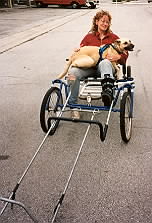
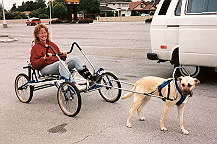
When I broke my foot, a friend arranged the loan of a sled-racing training cart with wheels. Remington was less than thrilled and preferred to have someone else do the pulling.
The year before my broken foot, I had started competing in agility. Just 6 trials that year. As my foot healed, I discovered that I wanted to spend time doing agility. Never went back for more obedience lessons, tracking lessons, or "acting" lessons.
I like agility because it involves both of us acting as a team at all times on the course, it's exciting, it's physically active and calorie-burning for both of us, it's mentally challenging for both of us, I can practice in my yard (now that I have enough equipment and almost enough space), judging is largely objective, not subjective, and all of my dogs have seemed more than eager to do it any time, anywhere.
I've watched flyball, dock diving, freestyle (dance), rally-O, disc dog, herding, and lure coursing, and have read up quite a bit on all of these sports.
* Obedience and rally-O work you as a team and you can practice in your yard, but none of the rest (for me and my dogs, anyway).
* Tricks fill several of the items but not the physically active or calorie-burning bit, and "judging" is very subjective if you enter any kind of contest.
* Dock diving and flyball are all about the dog; all the handler does is get the dog excited and then watch him go. (Sorry, fans of these sports, I know there's training involved, but really--the handlers are watchers, not participants.)
* Scent tracking--nothing there for me.
* Lure coursing: Boost will do it sometimes but sometimes not; it terrifies Tika; and it's VERY expensive for what you get IMHO. And no teamwork, no training, nuthin' except fast running for the dog.
* Disc dog: Maybe if I thought I could throw a frisbee worth beans, it would be OK, but physically it's still more about the dog and performance standards are largely subjective.
* Freestyle: Just doesn't appeal to me.
* Herding: Have had Boost on goats/sheep a few times. It is a complete blast watching the instincts guide her. If I had a lot more time and money, I'd probably pursue this just because of that. But--can't do it in my yard, not even in my city--too urban, there's just nowhere available!
The mentally challenging part of agility is important for me; every course is different, so you're designing strategies during the walkthrough even for numbered courses. And the execution is done with your partner moving at 5 yards per second and you have to adjust on the fly as Things Happen.
And one big thing: even after all these years, when I walk up and see an agility course with its brilliantly painted equipment in glowing rainbow colors spread out across the bright green lawn, it gives me the same Disneyland thrill and awe that hit me the first time that i ever saw an agility course, that night at Power Paws when I drove up to see what it was all about.
Labels: agility the sport, other dog sports, what it's all about
Complete list of labels

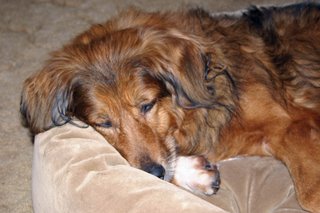


 When Remington came along, I took up the competitive obedience thing again; Mixed Breed Dog Club of America and UKC (and others?) provided same titles with same rules for non-AKC dogs. Learned a lot. Took private lessons from an instructor with a lot of successful students. Remington did very well. But I didn't find it exciting, really, or particularly active, although the ideas for training intrigued me. Practice was dull dull dull. And, the more I found out about the rigid SUBJECTIVE performance standards, the less thrilled I became. But I kept with the training with that "obedience champion" goal in mind until I broke my foot in early 1997.
When Remington came along, I took up the competitive obedience thing again; Mixed Breed Dog Club of America and UKC (and others?) provided same titles with same rules for non-AKC dogs. Learned a lot. Took private lessons from an instructor with a lot of successful students. Remington did very well. But I didn't find it exciting, really, or particularly active, although the ideas for training intrigued me. Practice was dull dull dull. And, the more I found out about the rigid SUBJECTIVE performance standards, the less thrilled I became. But I kept with the training with that "obedience champion" goal in mind until I broke my foot in early 1997.

